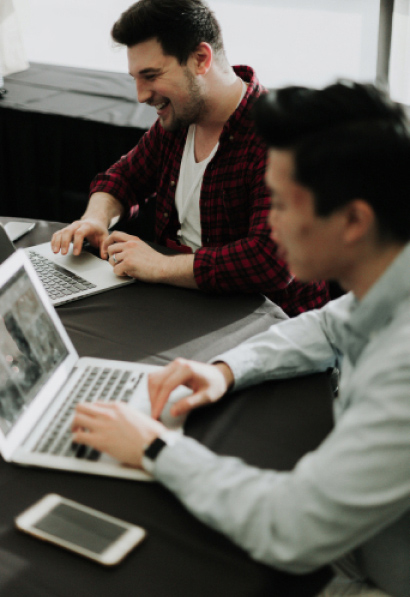Oculus is a responsive portfolio WordPress theme developed for portrait photographers. This modern and elegant theme allows you to show off your skills and craft effortlessly.
Learn how you can get the most out of the theme with the Oculus WordPress theme documentation.
Oculus WordPress theme documentation, step 1: Theme specifications
- Logo recommended width is 220px.
- The portfolio featured image recommended width should be 800px.
- Page and Post content maximum width is 740px.
Oculus WordPress theme documentation, step 2: Theme installation
The theme can be installed through the WordPress Admin panel.
- Log in to the WordPress Admin panel.
- Go to Appearance -> Themes.
- Click on the Add New button, at the top of the screen.
- In Add Themes screen, click on Upload Theme.
- Click on Choose theme, and then browse for theme file on your computer.
- Click on Install Now to start the install process.
- After the installation is done, click on Activate theme.
A detailed video for theme installation is available here: https://help.themeskingdom.com/how-to-install-and-setup-the-theme.
After activating the theme, you will be prompted to install the required plugins. Required plugins in the Oculus WordPress theme documentation are:
Oculus WordPress theme documentation, step 3: Theme setup
To set up the theme, please follow the next steps:
- Go to Pages -> Add New and create four new pages with the following titles: About, Home, Now available for hire, and What’s new. All pages are using the default page template.
- Insert a contact form into the Now available for hire page.
- Go to Posts -> Add New and create several new posts.
- Time to create portfolio items – in Portfolio -> Add New create several portfolio items. Be sure to set featured images for each portfolio item, and tag them with the same tag – e.g. Featured. This tag will be used to set the portfolio slider on the homepage.
- Go to Settings -> Reading. Set theme to use static page, and for home page set “Home” page, and for posts page set “What’s new”.
- In Appearance -> Menus create a new menu – Primary and add all your pages to it. Set that menu as Primary.
- Finally, add a personal touch to the site. Go to Appearance -> Customize and set the following things:
- In the Site Identity section, set the logo and favicon.
- Content Options: Turn on all options.
- Featured Content: Enter the tag used for the portfolio items that you wish to appear in the featured slider on the homepage. Set slider to look as a Film Strip, and uncheck other options.
- In Theme Settings -> Footer Settings enter the desired footer copyright text. You can use HTML tags to style the text.
- In Theme Settings -> Header Settings disable sticky header.
- Theme Settings -> Layout Settings, set portfolio archive layout to four columns, and check options Split layout in portfolio posts and Split layout in regular posts.
If you want to customize the theme and a personal touch to it, be sure to read the following text:
Oculus WordPress theme documentation, step 4: The Customizer
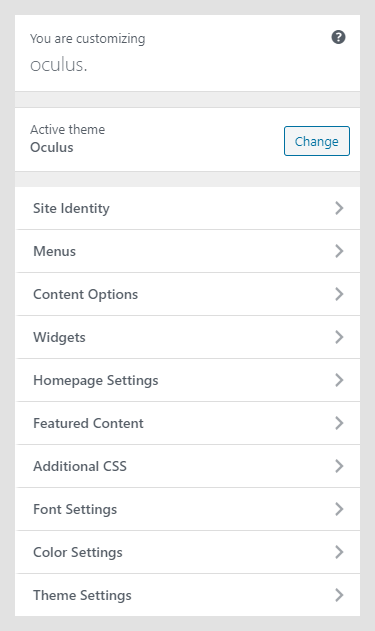
The Customizer is a great WordPress feature that allows you to customize the theme and set theme options. We will not explain all options since some of them are WordPress standards. Theme specific settings:
- Site Identity
- Background Image
- Menus
- Content Options
- Widgets
- Homepage Settings
- Featured Content
- Additional CSS
- Font Settings
- Color Settings
- Theme Settings
Site Identity
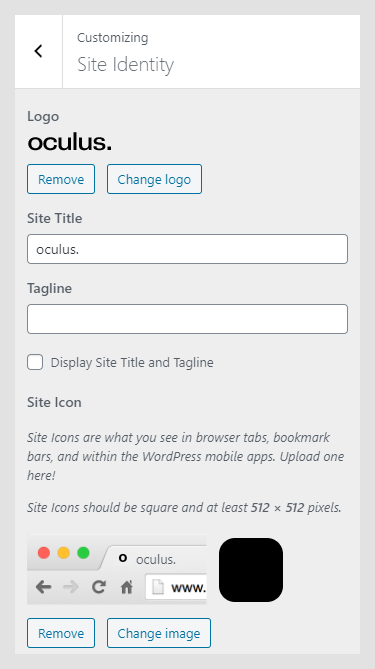
Site Identity in the Oculus WordPress theme documentation allows you to set your site title, tagline, and icon. The Site Title is the name of your site and it’s displayed in the header, where the logo is displayed. A Tagline is a short description or your motto, and it’s displayed just under the title. This setting is the same as in Settings -> General in WordPress admin panel.
- Logo: Upload logo for your site. The logo should be in a PNG or JPEG/JPG format.
- Site Title: Name of your site.
- Tagline: Site punchline.
- Display Site Title and Tagline: If enabled, both Site Title and Tagline will be displayed. The Tagline will be displayed under the title.
- Site Icon: The Site Icon is used as a browser and app icon for your site. Icons must be square, and at least 512px wide and tall.
Background Image
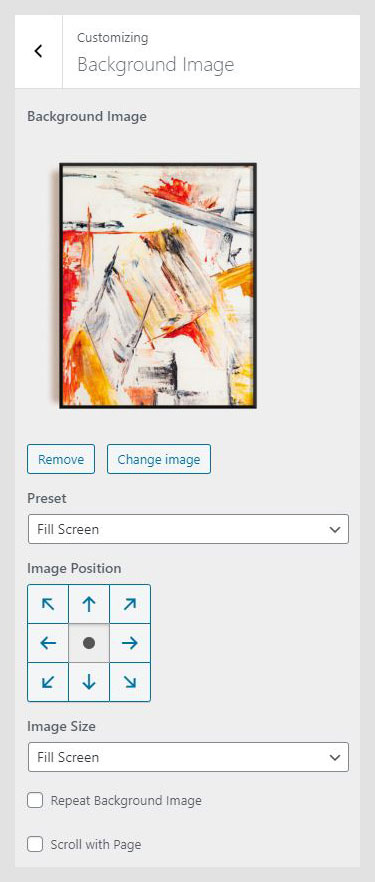
Depending on the use case, some users need to set a background image on the site. In the Background Image panel, you can set a background image. After choosing an image, you will be able to set background behavior.
- Preset: Defines image size – Fill Screen will stretch the image to fill the whole site; Fit to the screen will cover the only visible part of the site, and Repeat will keep original image proportions, but it will repeat the image. The Custom option allows you to manually set background parameters.
- Image Positions: Tool used to define the starting position for the image.
- Scroll with Page: Option available only if the background image is set to Repeat. If checked, the background will scroll together with the page content.
Menus

The Customizer menu option allows the user to manage available menu locations, and add and remove menu items.
Content Options

The Content Options panel contains settings for metadata for single posts – both regular and portfolio.
- Author Bio: If enabled, the author bio box will be displayed on the single post page.
- Display date: If enabled, the publishing date will be displayed on a single and posts page.
- Display categories: If enabled, post categories will be displayed on a single and posts page.
- Display tags: If enabled, post tags will be displayed on a single and posts page.
Widgets
Widgets in the Oculus WordPress theme documentation are useful extensions for content, which you can add to your sidebar or other widget areas. In the Widgets option in the Customizer, you can see available widgets area in the currently active theme.
Homepage Settings
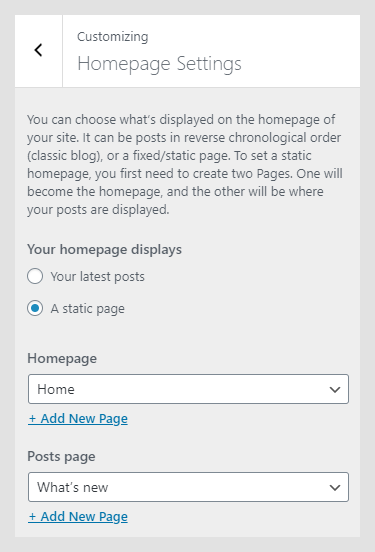
Homepage Settings work the same way Reading settings in Settings -> Reading does. Homepage settings allow you to set the theme to use static homepage, or to display the latest posts.
Featured Content
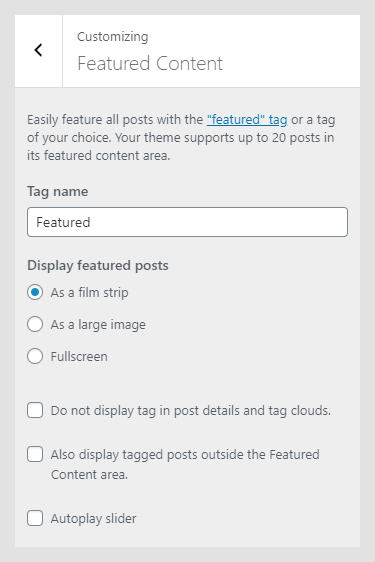
Featured Content in the Oculus WordPress theme documentation is displayed as a screen covering slider on the landing page. Five latest posts with the entered tag will be displayed as featured content.
- Tag name: Enter the tag related to posts which you wish to display in the slider.
- Display featured posts: Featured posts can be displayed as a film strip, larger image, or as a full-screen slider.
In our demo: http://resonant-photographer.tkdemos.com, we have set a page with a default page template as a landing page. That way, no other content is displayed, but the slider. If you set a static page with a Portfolio template, then portfolio items will be displayed under the slider. - Do not display the tag in post details and tag clouds. If enabled, the featured content tag will not appear in post meta and/or tag cloud.
- Also, display tagged posts outside the Featured Content area: If enabled content displayed in the slider will be displayed on archive pages, as well.
Setting up the slider
To set up the slider:
- Go to Settings -> Reading. Select the homepage to display Your latest posts.
- Go to Posts -> Add New. Create several posts or portfolio items. For each post enter the title, and set a featured image. Tag desired posts with the same tag e.g., Featured. The tag will be used to identify and display desired posts as a slider.
- Finally, go to Appearance -> Customize, and under Home Slider Options -> Slider – Featured Content enter the tag used for the posts.
Oculus WordPress theme documentation, step 5: Additional CSS
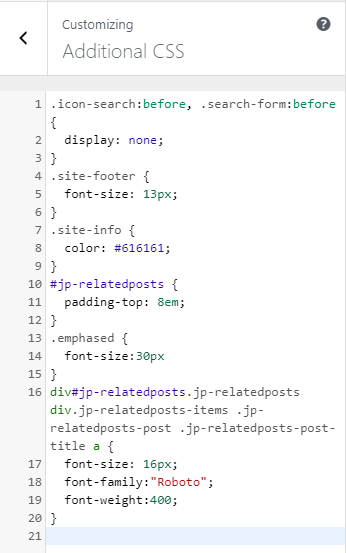
In the Additional CSS section, you can enter your custom CSS classes, so you don’t need to mess with original styles, or create a child theme. Of course, you should create a child theme if you plan to modify other files.
Font Settings
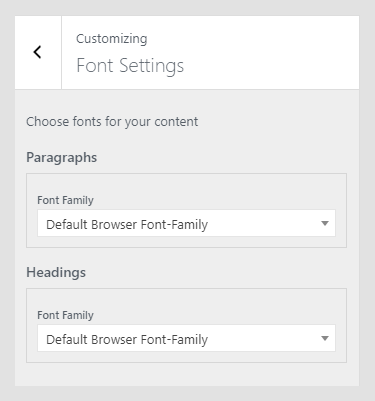
Font Settings allow you to set the font-family and font-weight for headings and paragraphs.
Color Settings

The Colors panel allows you to set header text and background colors.
Theme Settings
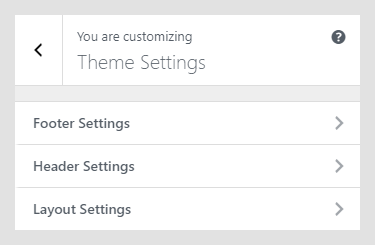
The Theme Settings panel contains theme-specific settings.
Footer Settings
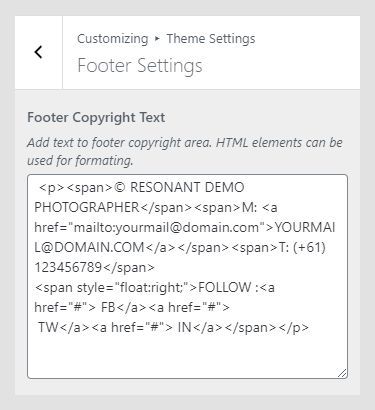
Footer Settings panel in the Oculus WordPress theme documentation is used to set footer copyright text. You can insert HTML if you need to create links, bold text, and such.
Header Settings
The Sticky header option can change the behavior of the site navigation. If the Sticky header is enabled, it will be always visible at the top of the screen.
If disabled, the header will scroll together with the page.
Layout Settings
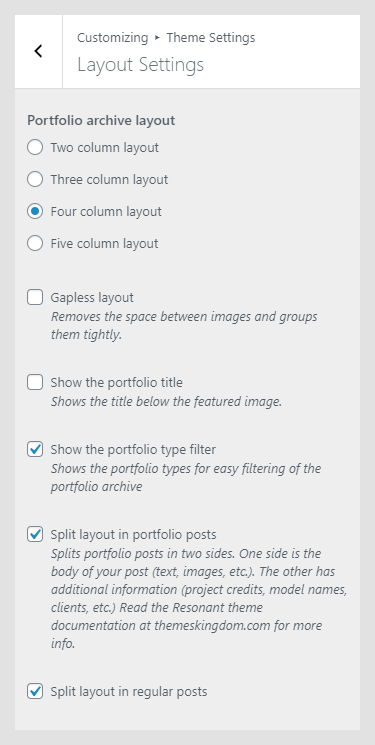
Layout Settings have options for setting the number of columns and portfolio and single post appearance.
- Portfolio archive layout: Portfolio archive can display portfolio items in two, three, four or five columns.
- Gapless layout: If enabled, images on the Portfolio page will be displayed without the gap between them.
- Show the portfolio title: If enabled, the portfolio title will be displayed under portfolio items on the Portfolio page.
Otherwise, the portfolio item title will be displayed on a mouse hover over a single portfolio item. - Show the portfolio type filter: If enabled, portfolio categories will be displayed above portfolio items as a filter.
- Split layout in portfolio posts: Splits portfolio posts on two sides. One side is the body of your post (text, images, etc.). The other has additional information (project credits, model names, clients, etc.)
- Split layout in regular posts: If enabled, the post will be split into two sections – one side with a featured image and the other with the post content.
Oculus WordPress theme documentation, step 6: Useful CSS classes
Modify site title font size
.site-branding .site-title a {
font-size: 16px;
}
Modify navigation font size
.nav-menu li a {
font-size: 20px;
}
Remove strikethrough line
.nav-menu a:before {
display: none;
}
Hide search
.big-search-trigger {
display: none;
}
Change highlight background and text color
.highlighted-text {
color: #fff;
background-color: #000;
}
Change page title size
.page-header .page-title {
font-size: 42px;
}
